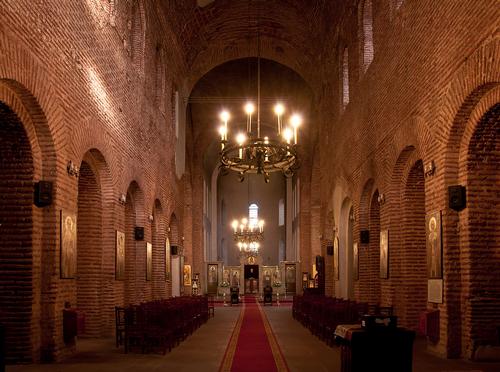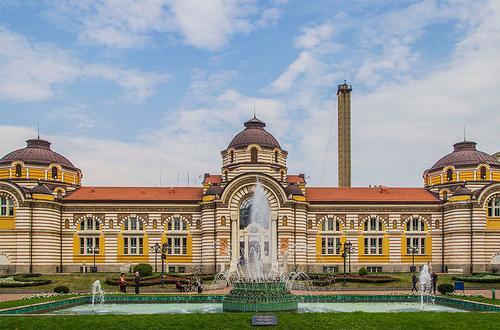BULGARIA
Sofia

Sofia
Sofia
Sofia is often referred to as "the heart of the Balkans" and for good reason. The sparkling Bulgarian capital is full of tangible history. You can view many monumental buildings and you can also enjoy the authentic Bulgarian atmosphere and the beautiful mountainous surroundings in which Sofia is located.
 SofiaPhoto: Boby Dimitrov CC 2.0 no changes made
SofiaPhoto: Boby Dimitrov CC 2.0 no changes made
| advertisement |
| Hotels Sofia |
Location
Due to Sofia's favorable location in the middle of the Balkans, the city quickly grew into the largest city and capital of Bulgaria. To be precise, the city is located in the western part of Bulgaria. Sofia is located in the Sofia Valley at the Vitosha Mountains. The city has an area of more than a thousand square kilometers and around 1.4 million inhabitants.
Weather
Sofia, like the rest of Bulgaria, has a moderate continental climate. This is a climate with large differences in weather conditions between the seasons. In the summer months the temperature in Sofia can reach well above 25 ° C and it rains regularly. In winter it can freeze considerably and there is often snow.
The mountains that surround Sofia affect the city's weather. In the summer it can cool down considerably in the evening and in the winter the mountains ensure that it is almost windless. Smog and fog often lingers over the city. Below you will find an overview of the average temperatures, the average number of hours of sunshine per day and the average number of days of rainfall per month in Sofia.
- Weather in Sofia January: 0°C, 3 hours of sunshine, 7 days of rainfall
- Weather in Sofia February: 2°C, 4 hours of sunshine, 7 days of rainfall
- Weather in Sofia in March: 6°C, 5 hours of sunshine, 7 days of rainfall
- Weather in Sofia April: 11.5°C, 7 hours of sunshine, 7 days of rainfall
- Weather in Sofia in May: 16°C, 8 hours of sunshine, 8 days of rainfall
- Weather in Sofia in June: 19.5°C, 9 hours of sunshine, 9 days of rainfall
- Weather in Sofia July: 22°C, 10 hours of sunshine, 6 days of rainfall
- Weather in Sofia August: 21°C, 10 hours of sunshine, 5 days of rainfall
- Weather in Sofia September: 18°C, 8 hours of sunshine, 4 days of rainfall
- Weather in Sofia October: 12°C, 6 hours of sunshine, 5 days of rainfall
- Weather in Sofia November: 7.5°C, 4 hours of sunshine, 6 days of rainfall
- Weather in Sofia December: 2°C, 3 hours of sunshine, 8 days of rainfall
History
Bulgaria is believed to have been inhabited by the Serden long before Christ (some 50,000 to 100,000 years). They called the place Serdica. Presumably they lived in Dofia until 29 BC until the city came into the hands of the Romans.
 Interior Sveti Sofia churchPhoto: Plamen Agov studiolemontree.com CC 3.0 Unported no changes made
Interior Sveti Sofia churchPhoto: Plamen Agov studiolemontree.com CC 3.0 Unported no changes made
Sofia got its current name when the Slavic Bulgars took control of the city. In 1376 they officially renamed the city Sofia, named after the Sveti Sofia Church. In 1382 the city was added to the Ottoman Empire under the Turks. The Turkish occupation would last almost 500 years. In these years Sofia grew into a significant trading center.
In 1878 the Russians liberated Sofia from the Turks. Bulgaria became Principality of Bulgaria until 1908 and then Principality of Bulgaria. When World War II broke out, the Bulgarians supported the Nazis. That is why Sofia was bombed by the Allies. There was a lot of damage and several historic buildings were destroyed. After the war, the country was occupied by the Soviet Union and became a communist state. It was not until 1990 that communism disappeared from Bulgaria and Sofia.
Sights
One of the most special sights in Sofia is the Synagogue. This is the third largest synagogue in Europe. The church building is located in the center and was opened in 1909. The building was designed by the Austrian architect Grünander and is built in Neo-Moorish style. The Sephardic Synagogue in Vienna was exemplary for the design. Not many services are held in the synagogue anymore, as most of the Jewish congregation, once well represented in Sofia, has emigrated to Israel.
 Synagogue SofiaPhoto :Vassia Atanassova CC 3 .0 Unported no changes made
Synagogue SofiaPhoto :Vassia Atanassova CC 3 .0 Unported no changes made
The National Palace of Culture is a distinctively designed building. It can best be described as a contemporary castle. The design was designed by Alexander Barov. On an area of over 120,000 m², there are eight floors with halls, exhibition areas, conference rooms and a trade center.
 Alexander Nevski Cathedral SofiaPhoto: Pudelek CC 3.0 Unported no changes made
Alexander Nevski Cathedral SofiaPhoto: Pudelek CC 3.0 Unported no changes made
The Orthodox cathedral Alexander Nevski is a must during a visit to Sofia. The cathedral has an imposing appearance and construction started in the year 1882. In the evening, the Alexander Nevski cathedral is beautifully lit. Behind the cathedral is the parliament.
Sofia is known for the mineral baths that can be found in the (surrounding of the) city. The baths are no longer in use, but are worth a visit because of the particularly beautiful architecture. The baths date from the 20th century.
 Mineral badths SofiaPhoto: Miroslav Nikolov CC 4.0 International no changes made
Mineral badths SofiaPhoto: Miroslav Nikolov CC 4.0 International no changes made
Tips
You can make a very nice outing to the Sofia zoo. The zoo was opened in 1888, making it the oldest zoo in Bulgaria. The zoo covers no less than 230,000 square meters and is home to all kinds of different animal species, including a number of endangered and local animals.
Various events are organized in Sofia. It is advisable to attend an event during your stay if possible. For example, go to "SeeMe Sofia" (South-East European Music Exhibition) in September. This is a large three-day music festival where mainly DJs perform. During this festival you can taste the innovative atmosphere of Sofia.
Useful links Sofia
BBC Country ProfilesWorld Fact Book Explore all Countries
How to call
Last updated June 2025
Copyright: Team - The World of Info